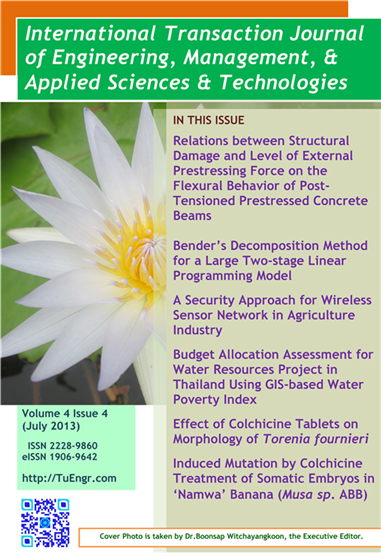International Transaction Journal
of Engineering, Management,&
Applied Sciences & Technologies
:: International Editorial Board:
|
Archives
Vol.4(4) (Oct 2013)


:: International Transaction Journal of Engineering, Management, & Applied Sciences & Technologies
http://TuEngr.com

 Cover V4(4) October 2013 Cover V4(4) October 2013
ISSN 2228-9860
eISSN 1906-9642
FEATURE PEER-REVIEWED ARTICLES
Thananun Phuwadolpaisarn, Sayan Sirimontree *, and Boonsap Witchayangkoon (Department of Civil Engineering Faculty of Engineering, Thammasat University, THAILAND)
|
Keywords: Flexural rigidity; Post-Tension; Strengthening; Repair Prestress; Structural rigidity; Beam girder;
Full scale test.
Abstract
Prestressed concrete beams can be damaged by overloading beyond cracking stage leading to the reduction of flexural rigidity and
excessive deflection. The progressive of damage, crack and permanent deflection can be occurred at the high level of load after cracking.
Structural performance of damaged girder can be recovered and improved by external post tension. The level of external prestressing
force required in strengthening depends directly on the level of damage due to overloading. This research studied the effect of levels
of damage on flexural rigidity, crack and deflection of the test girder. Three levels of damage can be expressed in terms of 0.65, 0.75 and 0.85 times the predicted ultimate load of the test beam. Three levels of external prestressing forces (2, 2.5 and 3 times of the internal prestressing force applied in undamaged reference beam) are applied in strengthening at each level of damage. The results show that reduced flexural rigidity, increased permanent deformation and crack width due to overloading can be recovered by external post tension. Strengthening by means of external post tension can be effectively applied to the damaged beam at the level of damage not more than 0.65 times of predicted ultimate load.
Somsakaya Thammaniwit * and Peerayuth Charnsethikul ( Industrial Engineering, Department, Faculty of Engineering, Kasetsart University, Bangkhen, Bangkok, 10220, THAILAND )
|
Abstract
Linear Programming method (LP) can solve many problems in operations research and can obtain optimal solutions. But, the problems with uncertainties cannot be solved so easily. These uncertainties increase the complexity scale of the problems to become a large-scale LP model. The discussion started with the mathematical models. The objective is to minimize the number of the system variables subjecting to the decision variable coefficients and their slacks and surpluses. Then, the problems are formulated in the form of a Two-stage Stochastic Linear (TSL) model incorporated with the Bender’s Decomposition method. In the final step, the matrix systems are set up to support the MATLAB programming development of the primal-dual simplex and the Bender’s decomposition method, and applied to solve the example problem with the assumed four numerical sets of the decision variable coefficients simultaneously. The simplex method (primal) failed to determine the results and it was computational time-consuming. The comparison of the ordinary primal, primal-random, and dual method, revealed advantageous of the primal-random. The results yielded by the application of Bender’s decomposition method were proven to be the optimal solutions at a high level of confidence.
Piya Techateerawat * ( Department of Electrical and Computer Engineering, Faculty of Engineering, Thammasat University, Klong Luang, Pathumthani, THAILAND )
|
Keywords: Security Framework; Key Distribution; Intrusion Detection System.
Abstract
An overview of agriculture industry is involved with large area, farmers and agriculture products. A large scale of area requires time consuming for collecting data to make decision on agriculture (e.g. watering, pruning and harvesting.). From these requirements, wireless sensor network can be a supported technology because it can deploy distributed and construct network sharing among their group. In general, security solution needs an experienced and skilled specialist to set up, maintain and troubleshoot. This is a challenge for wireless sensor network to implement in agriculture industry. Our security approach is presented related factors and customized configuration for the process of deployment, maintenance, information feedback. This paper presents the security mechanism to support the needs of self-setup and minimum operation for wireless sensor network in agriculture industry. The security module has automated initiate key by HKD protocol and has Adaptive IDS to alert when threat is detected via speaker. This system is also simplified the configuration, deployment and maintenance by only powering on and system will then initiate the key among the agents. As a result, this security module is proposed to balance between the moderate security with the limited resource and technician.
Supet Jirakajohnkool * , Uruya Weesakul ( Department of Civil Engineering, Faculty of Engineering, Thammasat University, THAILAND ) Sarintip Tantanee ( Department of Civil Engineering, Faculty of Engineering, Naresuan University, THAILAND )
|
Keywords: Geographic Information Systems;
Water Management;
GIS-Based Index;
water budget allocation
Abstract
During the last 5 years, Thailand has allocated water budget to mitigate water resources problems totally THB 100,460 million (US$31264 million). However, it is found no study to assess whether such allocation corresponds to the problems or to water demand. This study, therefore, assesses appropriateness of the budget allocation to 25 major basins in Thailand by applying the concept of Water Poverty Index (WPI). WPI is developed by Sullivan (2002) consisting of five main factors of Resources (R), Access (A), Capacity (C), Use (U) and Environment (E). Sub-factors of 22 variables have also been selected based on the physical and geographical characteristics of 25 major river basins. Data are scored for priority. GIS is cooperated the results of water shortage area according to priority on basin basis.
It is found that WPI scores of Mae Nam Pattani, Mae Nam Kok, Peninsula - West Coast, Mae Nam Mun, Mae Nam Chi, Mae Nam Salawin and Mae Nam Khong (Northeast) were low, which reflected a higher level of water shortage than other basins. By considering water budget allocation per capita, it was found that Mae Nam Kok, Mae Nam Chi, Mae Nam Mun, were allocated less budget compared to other basins. Thus, water budget allocation is inconsistent with the water poverty index. However, the WPI scoring system is based only on water poverty. Future study should integration of disaster index into the scoring system, to improve the efficiency of budget allocation system.
Sasiree Boonbongkarn, Thunya Taychasinpitak * , Shermarl Wongchaochant ( Department of Horticulture, Faculty of Agriculture, Kasetsart University, Jatujak, Bangkok 10900. THAILAND ) and Shinji Kikuchi ( Graduate School of Horticulture, Chiba University, Chiba, JAPAN )
|
Keywords: Polyploid induction;
Cromosome;
Flow cytometry;
Morphological characteristics;
Cytological characteristics.
Abstract
The effects of colchicine tablets on Torenia fournieri were studied. Leaves were cut and soaked in different concentrations of colchicine solution: 0, 5, 10, 15 and 20 ppm for 0, 1, 2 and 3 days. The survival rate decreased when colchicine concentration and treatment duration were increased. The stomata length was found to be greater in the putative polyploids. Flow cytometric analysis demonstrated that the nuclear DNA of putative polyploid Torenia plants was doubled relative to that of control diploid plants, and microscopy results confirmed that the chromosome number of the tetraploid plants was 2n = 4x = 36. The highest frequency of tetraploid induction was 6.67% at 15 ppm of colchicine solution soaked for 3 days. Morphological characteristics of tetraploid and diploid plants were compared. The results showed that growth of tetraploid plants were less than diploid plants. Tetraploid plants also had larger leaves and flower sizes when compared with diploid plants.
Beyene Demtsu ( Department of Horticulture, Faculty of Agriculture, Kasetsart University, Jatujak, Bangkok 10900. THAILAND and Tigrai Agricultural Research Institute (TARI), Tigrai, ETHIOPIA ) , Thunya Taychasinpitak*, Shermarl Wongchaochant, and Benya Manochai ( Department of Horticulture, Faculty of Agriculture, Kasetsart University, Jatujak, Bangkok 10900. THAILAND )
|
Keywords:
Flow cytometry; Hexaploids; Polyploid; Embryogenesis; Tetraploid.
Abstract
Hexaploids of the ‘Namwa’ banana (Musa sp ABB) were obtained by in vitro colchicine treatment of somatic embryos. Somatic embryos were induced on a medium containing MS medium supplemented with 8 mg/l picloram. Somatic embryos were treated with four different concentrations of colchicine (0, 0.3, 0.5, 1.0, %) in liquid MS medium supplemented with 0.22 mg/l zeatin, and shaken (60 rpm) at 25 0C in darkness for 48, 72 or 96 hours. Higher colchicine concentrations exhibited higher mortality rates ranging from 8–20%, 48–62% and 80–90% mortality on concentrations 0.3, 0.5, and 1.0 % colchicine respectively. Mortality rate generally increased with increased treatment time. Hexaploids were obtained at a frequency of 2 % with treatments 0.05 % colchicine for 96 hours, and 1 % colchicine for 48 hours as determined by flow cytometry.
Previous: Vol 4(3) October 2013 ......... Next: Vol 5(1) January 2014
Call-for-Papers
Call-for-Scientific Papers
Call-for-Research Papers: ITJEMAST invites you to submit high quality papers for full peer-review and possible publication in areas pertaining engineering, science, management and technology, especially interdisciplinary/cross-disciplinary/multidisciplinary subjects.
To publish your work in the next available issue, your manuscripts together with copyright transfer document signed by all authors can be submitted via email to Editor @ TuEngr.com (no space between). (please see all detail from Instructions for Authors)
Publication and peer-reviewed process:
After the peer-review process (4-10 weeks), articles will be on-line published in the available next issue. However, the International Transaction Journal of Engineering, Management, & Applied Sciences & Technologies cannot guarantee the exact publication time as the process may take longer time, subjected to peer-review approval and adjustment of the submitted articles.


|



 Cover V4(4) October 2013
Cover V4(4) October 2013




